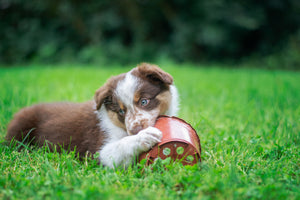3 min read • By Wyatt West, Staff Writer and Outdoor Fiend, Timberdog
Why do dogs chew?
Dogs have a natural instinct to chew, which helps keep their teeth clean and their jaws strong. However, excessive chewing can become a problem, leading to damaged pet beds, furniture, shoes, and other household items. A dog's anxious gnawing can come from fear, trauma, resistance to training/acting out ("revenge" chewing), boredom, pent-up energy that needs to be released, or simply trying to get your attention for some reason.
First seek to understand - as best you can - why your dog is chewing everything up in the first place. And then take the following steps to help address her behavior.
1. Provide appropriate chew toys
Make sure your dog has access to a variety of safe and durable chew toys. This will redirect their chewing behavior to appropriate items and help satisfy their natural urge to chew. When my dog Angus was teething, or into destroying things when I left the house, I took to stuffing Kongs with a bit of peanut butter and his kibble and hiding them around the house, especially near places he loved to chew things (furniture, a pile of laundry, his pet bed, etc.). I also bought a few "treat puzzles" which made accessing treats pretty difficult. I'd often come home to find Angus still working on some of those!
2. Keep valuable and dangerous items out of reach
Prevention is key. Keep valuable or dangerous items out of your dog's reach to avoid temptation. This includes shoes, clothing, electrical cords, and household chemicals.
3. Use taste deterrents
Apply taste deterrents, such as bitter apple spray, to items you want to protect. The unpleasant taste will discourage your dog from chewing on them. Unfortunately, for power chewers, bitter apple may not work. I had to resort to Tabasco on some select items that couldn't be stained. And that helped tremendously. One sniff of that, and Angus's head would jerk back comically.
4. Provide mental and physical stimulation
Boredom and excess energy can contribute to destructive chewing. Engage your dog in plenty of exercise (both intense cardio such as playing fetch, and steady state cardio like a brisk-paced walk) and provide mental stimulation through interactive toys.
5. Establish a consistent routine
Dogs thrive on routine. Establish a consistent schedule for feeding, exercise, and playtime. This will help reduce anxiety and provide structure, which can prevent destructive chewing.
6. Use positive reinforcement
When your dog chews on appropriate items, praise and reward them. Positive reinforcement will reinforce the desired behavior and make them more likely to repeat it.
7. Supervise and redirect
Keep a close eye on your dog, especially during the training phase. If you catch them chewing on something they shouldn't, calmly redirect their attention to an appropriate chew toy.
Angus was pretty feral when I adopted him, and calm redirections didn't work. I found a great workaround: a few powerful claps. When he would start chewing on something inappropriate, I'd clap loudly, and call him to me. Then I'd reward him for stopping his behavior and obeying the command to come. The clapping turned out to be a massively useful tool; now, just one clap and he'll stop any behavior -- not just chewing -- and run to me. He no longer expects treats for obeying this command, but I still occasionally give him something delicious to keep this discipline reinforced.
8. Address underlying anxiety or stress
Chewing can be a symptom of anxiety or stress. When it took longer than usual to fix Angus's chewing dilemma, I listened to my friends' advice and turned the TV on for him when I left home. He is one of those dogs that never even looks at the TV (even when I literally hold his head in the TV's direction, LOL), but the ambient noise of humans speaking in the background helped allay a lot of his abandonment fears.
I also bought a camera that has two-way audio (on Amazon, for $22!), so when Angus howled and cried, I'd speak to him through the camera and he'd hear my voice. His ears would suddenly perk and swivel in the camera's direction, and his howling would promptly end. On subsequent outings, I'd wait a bit longer before speaking to him on camera, increasing his tolerance, bit by bit, for staying home. Now, I barely use this camera to speak through; though, I'll occasionally check in to see what Angus is up to.
9. Crate train your dog
Crate training can be an effective way to prevent destructive chewing when you're unable to supervise your dog. Make sure the crate is comfortable and provide appropriate chew toys inside. I personally did not want Angus crated interminably, especially on long days when I had to direct a photo shoot, so I trained him to love his crate as his den, or safe space, and would leave the door open for him so he could come and go from his crate as he pleased. I loved the fact that he'd nap in there while I was gone.
10. Seek professional help if needed
If your dog's chewing habits are severe or causing significant damage, don't hesitate to seek professional help. A dog behaviorist or trainer can provide personalized guidance and support.
Photo credit: Ayla Verschueren

